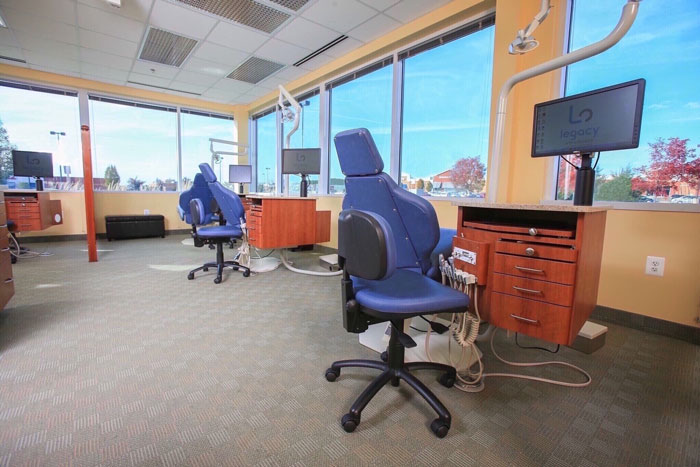Indicators on Legacy Orthodontics You Should Know
Indicators on Legacy Orthodontics You Should Know
Blog Article
Legacy Orthodontics Fundamentals Explained
Table of ContentsTop Guidelines Of Legacy OrthodonticsSome Known Factual Statements About Legacy Orthodontics What Does Legacy Orthodontics Mean?Our Legacy Orthodontics DiariesLegacy Orthodontics for Dummies
At Advanced Orthodontics, we give individuals with a all natural therapy experience. Furthermore, we provide flexible therapy schedules, versatile payment alternatives and a fun, delightful experience. leesburg orthodontics. Phone call ( 480) 357-4900 today for additional information and schedule a visit.An orthodontist is a dental expert educated to diagnose, protect against, and treat teeth and jaw abnormalities. Orthodontists function with individuals of all ages, from kids to grownups.
Malocclusion, or misaligned teeth, can cause oral concerns, including dental cavity, gum tissue condition, and difficult or excruciating chewing. Not everybody is birthed with straight teeth. If you have a negative bite or big spaces in between your teeth, you may desire to get in touch with a dental practitioner specializing in orthodontic treatment.
Legacy Orthodontics Things To Know Before You Buy
( Photo Credit Score: DigitalVision/Getty Images) Orthodontists make use of fixed and removable oral devices, like dental braces, retainers, and bands, to alter the placement of teeth in your mouth. Orthodontic treatment is for dental problems, consisting of: Crooked teethBite problems, like an overbite or an underbiteCrowded teeth or teeth that are too much apartJaw misalignmentThe goal of orthodontic treatment is to improve your bite.
While you might believe of orthodontists as mainly for youngsters or teens who require braces, they can correct oral issues at any kind of age. Orthodontists go to college, dental institution, and orthodontic college.
All orthodontists are dentists, however not all dental experts are orthodontists. Orthodontic residency programs use extensive, focused guideline for dental professionals. They concentrate on two locations: How to properly and safely relocate teeth Exactly how to appropriately guide growth in the teeth, jaw, and faceOnce an orthodontist has completed training, they have the option to end up being board accredited.
7 Simple Techniques For Legacy Orthodontics
Misalignment, or malocclusion, is the most common reason people see an orthodontist. It is hereditary and is the outcome of size differences in between the upper and reduced jaw or between the jaw and teeth. Malocclusion leads to tooth overcrowding, a misshapen jaw, or uneven bite patterns. Malocclusion is normally treated with: Your orthodontist affixes steel, ceramic, or plastic square bonds to your teeth.
If you have just minor malocclusion, you might have the ability to make use of clear dental braces, called aligners, rather than traditional braces (https://hubpages.com/@legacyortho). Some individuals need a headgear to aid relocate teeth right into line with stress from outside the mouth. After dental braces or aligners, you'll require to put on a retainer. A retainer is a custom tool that keeps your teeth in position.
They're usually utilized on kids. They can create added room in the mouth without having to pull teeth. If you have a major underbite or overbite, you may require orthognathic surgical procedure (also called orthodontic surgical procedure) to extend or reduce your jaw. Orthodontists utilize cords, medical screws, or plates to sustain your jaw bone.
You might require to see an orthodontist if you have: Crowding or otherwise enough area for every one of your teethOverbite, when your upper teeth come over your base teethUnderbite, when your base teeth are also much forwardSpacing or issues with gapsCrossbite, which is when your upper teeth fit behind your base teeth when your mouth is closedOpen bite or an upright space in between your front base and upper teethMisplaced midline, when the center of your base and top teeth don't align Remedying an oral malocclusion can: Make attacking, chewing, and talking easierImprove the balance of our face and your total appearanceEase discomfort from temporomandibular joint problemsDifferent your teeth and make them much easier to cleanse, aiding prevent dental caries or tooth cavities It's typically a dental practitioner who initially notices misaligned teeth during a routine exam.
7 Simple Techniques For Legacy Orthodontics

Throughout your initial orthodontic assessment, you'll likely have: A dental examPhotos taken of your face and smileDental X-raysPanoramic (360 level) X-rays of your face and headImpressions to produce molds of your teethThese examinations will certainly aid your orthodontist know how to proceed with your treatment. invisalign. An orthodontist is a dental professional who's had training to treat your teeth and jaw
An orthodontist is focused on your bite, so something like a damaged tooth would certainly be taken care of by a dentist. Orthodontists are focused on your bite, or the method your teeth fit with each other, and the straightness of your teeth.
Ever wondered how stars constantly appear site to have perfectly aligned teeth? The response usually exists in the competent hands of an orthodontist. What specifically does an orthodontist do? Orthodontists are dental specialists who concentrate on fixing irregularities in the teeth and jaws. Their experience goes beyond simply creating an attractive smile; it includes improving your total dental health and feature.
Some Ideas on Legacy Orthodontics You Should Know

While braces are one of the most typically recognized orthodontic treatment, orthodontists have a varied toolkit at their disposal. The certain technique selected relies on the seriousness of the case, the individual's age, and private preferences. These reliable dental braces make use of a system of braces bonded to the teeth and connected by wires.
Clear aligners, like Invisalign, are a prominent alternative for clients seeking a more very discreet therapy choice. These detachable trays are tailor-made to considerably shift the teeth's placement. Headgear may be made use of in combination with dental braces or aligners to use extra targeted pressures, especially for fixing jaw discrepancies. In situations of slim jaws, palatal expanders can be made use of to produce room for appropriate tooth positioning.
Report this page